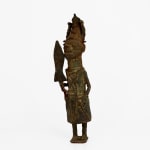Benin Figure of an Oba, with Ceremonial Sword (Eben), Eighteenth or Nineteenth Century AD
Bronze
39 x 11 x 8 cm
15 3/8 x 4 3/8 x 3 1/8 in
15 3/8 x 4 3/8 x 3 1/8 in
CC.54
Further images
-
(View a larger image of thumbnail 1
)

-
(View a larger image of thumbnail 2
)

-
(View a larger image of thumbnail 3
)

-
(View a larger image of thumbnail 4
)

-
(View a larger image of thumbnail 5
)

-
(View a larger image of thumbnail 6
)

-
(View a larger image of thumbnail 7
)

-
(View a larger image of thumbnail 8
)

-
(View a larger image of thumbnail 9
)

-
(View a larger image of thumbnail 10
)

-
(View a larger image of thumbnail 11
)

Benin kingship originates in the Twelfth Century AD, and was the embodiment of Benin cosmology, politics and history. The King, or Oba, was the source of wisdom and justice, the...
Benin kingship originates in the Twelfth Century AD, and was the embodiment of Benin cosmology, politics and history. The King, or Oba, was the source of wisdom and justice, the representative of the ancestors of the Benin people. Every year, at the royal thanksgiving festival (igwe), representatives of each Benin family were obliged to pay homage to the monarch as the ancestors’ representative on Earth. The Benin monarch was also a great patron of the arts. Benin metalworkers are considered among the finest artists in Sub-Saharan Africa, producing an oeuvre of immense creativity, energy and quality. Most of the famous Benin bronzes were created to commemorate the achievements or memory of important Obas.
This bronze depicts a standing Oba, wearing an elaborate crown and holding the ceremonial sword (eben) that symbolises the Oba’s power of life and death over his subjects. The king has a short forehead, large eyes and a flat nose above thick pouting lips. Around his neck he wears a series of neck-rings and an elaborate arrangement of necklaces, some of which reach down to his knees. His naked torso is long, constituting a third of the height of the sculpture. His arms are long and disproportionately thin, terminating in flat hands with extended fingers. He wears a knee-length striped kilt, and a long belt or string over his shoulder. His eben, or ceremonial sword, has the traditional leaf-shaped blade and a looped handle of twisted wire. His crown consists of a large fluted conical headpiece, with beads along the front, and two horn-like side pieces made of twisted wire. It is held on his head by a chinstrap that comes down before the ears.
The art of the Benin people only came to the world’s attention as a result of the tragic events of AD 1897. When a British trading expedition visited Benin City, the Oba, Ovonramwen, became concerned that they might interfere with royal rituals. The trading expedition was attacked, resulting in the deaths of six British officials and more than two hundred African porters. The British immediately launched a punitive expedition to the Benin Kingdom, and ruthlessly destroyed Benin City, burning it to the ground, and denuding it of its artworks. Our piece shows the damage of the conflagration in Benin City, and is a rare survivor of the expedition. This firmly dates it to before AD 1897, and perhaps as far back as the Eighteenth Century AD.
This bronze depicts a standing Oba, wearing an elaborate crown and holding the ceremonial sword (eben) that symbolises the Oba’s power of life and death over his subjects. The king has a short forehead, large eyes and a flat nose above thick pouting lips. Around his neck he wears a series of neck-rings and an elaborate arrangement of necklaces, some of which reach down to his knees. His naked torso is long, constituting a third of the height of the sculpture. His arms are long and disproportionately thin, terminating in flat hands with extended fingers. He wears a knee-length striped kilt, and a long belt or string over his shoulder. His eben, or ceremonial sword, has the traditional leaf-shaped blade and a looped handle of twisted wire. His crown consists of a large fluted conical headpiece, with beads along the front, and two horn-like side pieces made of twisted wire. It is held on his head by a chinstrap that comes down before the ears.
The art of the Benin people only came to the world’s attention as a result of the tragic events of AD 1897. When a British trading expedition visited Benin City, the Oba, Ovonramwen, became concerned that they might interfere with royal rituals. The trading expedition was attacked, resulting in the deaths of six British officials and more than two hundred African porters. The British immediately launched a punitive expedition to the Benin Kingdom, and ruthlessly destroyed Benin City, burning it to the ground, and denuding it of its artworks. Our piece shows the damage of the conflagration in Benin City, and is a rare survivor of the expedition. This firmly dates it to before AD 1897, and perhaps as far back as the Eighteenth Century AD.










